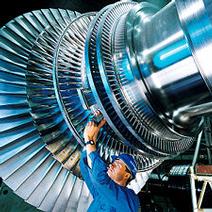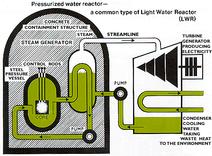Gap Measurement in Gas & Steam Turbines

With today’s global government focus on energy consumption and CO2 emissions, electrical energy suppliers are accelerating their demand for clean and efficient energy generation equipment. This in turn is driving gas and steam power turbine manufacturers to put even more focus on increasing turbine output efficiencies, lengthening intervals between major servicing and reducing the cost and downtime of their turbines.
Over the past 25 years Capacitec has been working closely with US, European, Japanese and Canadian turbine producers to help meet these goals designing purpose built non-contact capacitive displacement and gap sensing systems.
Typical gap measurement applications for Gas and Steam Power Turbines during production and rebuild include:
- Turbine blade to outer casing gap measurement
- Simultaneous measurements of 5 stages of rotor to stator gaps in a steam turbine to confirm the turbine eccentricity after re-build.
- Maintaining uniform gaps between heat exchanger tubes on nuclear steam turbine heat exchanger
1. Turbine Blade to Casing Gap Measurement
Global PowerGen gas and steam turbine manufacturing companies have come to Capacitec looking for a replacement of feeler gauges to measure gaps between turbine blades and casing during the production and re-build of their turbines. Although quality engineers found the feeler gauge gap measurement method economical, it failed to provide the Six Sigma accuracies to assure concentricity of the rotor assembly to the outer casing. More accurately centered rotor stages contribute to enhanced turbine efficiency and thus maximization of power turbine output. Meeting the nominally designed rotor position also avoids premature wear and blade damage due to blade contact with the casing where the worse case scenario is to have to disassemble and repair the turbine.
More specifically engineers need to measure hundreds of gap clearances along the axial outside edge of each of the rotors along the entire length of the turbine’s several different rotors stages. These gaps are measured near the horizontal split line where the diameter of the rotor meets outside casing prior to the final assembly of the turbine.
Based on these requirements Capacitec designed and developed a new series of flexible and self-grounded gap measurement sabers called the Contact Saber. Model GPD-4-A-350, a long skinny contact saber is currently in use along with the new Gapman Gen3 portable electronics package for the above-mentioned application allowing easy access and trouble-free measurement of numerous gaps along the axial outside edge of each of the rotors along the entire length of the turbine.
2. Simultaneous Rotor to Stator meaurement of 5 stages in a steam turbine
In an application for a Japanese turbine manufacturer, Capacitec supplied a custom Bargrafx System with 5 HPR-125x1500 rectangular non-contact probes that were used to take simultaneous measurements on 5 separate stages (rotor to stator) in a steam turbine to confirm the turbine eccentricity after re-build.
3. Maintaining uniform gaps between heat exchanger tubes on nuclear steam turbine heat exchanger

Heat exchangers are an integral step in a Nuclear Power Plant where water is heated to produce steam, which is then used to generate electricity. In some cases two heat exchangers are used in parallel, and when operating at full heat transfer capacity, each one individually provides sufficient cooling to safely operate the plant.
According to World-Nuclear.org "a Pressurized Water Reactor (PWR) includes a primary cooling circuit which flows through the core of the reactor under very high pressure, and a secondary circuit in which steam is generated to drive the turbine.
Water in the reactor core reaches about 325°C, hence it must be kept under about 150 times atmospheric pressure to prevent it boiling. Pressure is maintained by steam in a pressurizer (see diagram). In the primary cooling circuit the water is also the moderator, and if any of it turned to steam the fission reaction would slow down. This negative feedback effect is one of the safety features of the type.
The secondary circuit is under less pressure and the water here boils in the heat exchangers which are thus steam generators. The steam drives the turbine to produce electricity, and is then condensed and returned to the heat exchangers in contact with the primary circuit."
According to Alstom’s website “Nowadays modern power plants are provided with a closed water circuit. The intermediate cooling water system is filled with clean, fully desalinated and inhibited water. The waste of heat is emitted in the auxiliary or main cooling water circuit by the water-water cooler.
The main advantage of the intermediate cooling system is the avoidance of contact of external, often aggressive cooling water with the individual consumers. This improves reliability and focuses the maintenance required on the intermediate water-water cooler whose materials are chosen to be corrosion resistant. Alstom provides Water/Water Coolers of shell and tube type.”
Some of the industries heat exchanger models are made up of hundred of tubes used in the process. Engineers use mechanical feeler gages to measure tens of thousands of gaps between these heat exchanger tubes as a way to control the quality of the heat exchanger’s subsystem structure. The heat exchanger's substructure must be structurally sound to avoid vibrational harmonics that lead to premature failure of high-pressure steam lines in Nuclear Power Stations.
In a typical application, Capacitec has replaced the subjective and less accurate feeler gage method with a capacitive electronic gap measurement system including a GPD Style Contact Wand. This more modern electronic gap measurement technology has proven to save several hundred labor hours in the production of one assembly. In addition, Capacitec significantly improved accuracy in the process of measuring these tens of thousands of gaps between the heat exchanger tubes.
